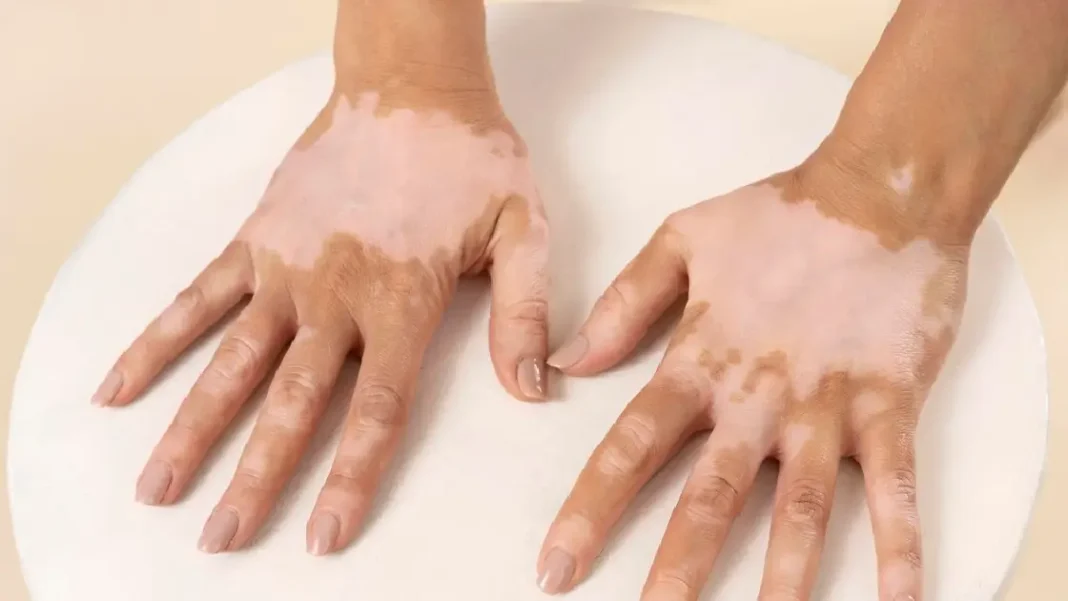Vitiligo is a long-term skin condition that causes pale white patches to develop on the skin due to a lack of melanin, the pigment responsible for skin color. This condition can affect anyone, regardless of age or ethnic background. Although vitiligo is not contagious or life-threatening, it can have a significant emotional and psychological impact on a person’s self-esteem and quality of life.
What Causes Vitiligo?
Vitiligo occurs when the melanocytes in the skin cells responsible for producing melanin are destroyed. The exact cause is still not fully understood, but it is widely believed to be an autoimmune condition, where the body’s immune system mistakenly attacks its own cells (Taïeb & Picardo, 2009).
Several factors may contribute to the development of vitiligo, including:
- Genetic predisposition (it tends to run in families)
- Autoimmune diseases such as thyroid disorders
- Environmental triggers like sunburn or exposure to certain chemicals
- Oxidative stress leading to cell damage
Although stress and trauma don’t directly cause vitiligo, they may trigger or worsen the condition in some individuals.
Common Symptoms of Vitiligo
The most noticeable symptom of vitiligo is the appearance of white patches on the skin. These patches can occur anywhere but are most commonly found on:
- Face and neck
- Hands and feet
- Around body openings (mouth, eyes, genitals)
Sometimes, people may also notice white or prematurely gray hair, loss of pigment in the inner mouth or nose, or changes in the color of the retina (Alikhan et al., 2011). Vitiligo usually begins slowly and may spread over time.
Types of Vitiligo
Vitiligo can be classified into different types:
- Generalized Vitiligo: Most common, affecting many parts of the body symmetrically.
- Segmental Vitiligo: Occurs on one part of the body and usually spreads slowly.
- Localized (Focal) Vitiligo: Limited to one or a few areas.
- Universal Vitiligo: Rare and involves nearly all skin surfaces.
Understanding the type of vitiligo can help determine the best treatment options.
How Is Vitiligo Diagnosed?
A dermatologist usually diagnoses vitiligo by examining the skin and asking about personal and family medical history. In some cases, a Wood’s lamp (a special ultraviolet light) is used to highlight areas of pigment loss.
Blood tests may also be done to check for autoimmune conditions or thyroid function, which are often associated with vitiligo (Casperson et al., 2009).
Treatment Options for Vitiligo
While there is no cure for vitiligo, many treatments can help restore pigment or even out skin tone. Options include:
- Topical corticosteroids: Reduce inflammation and may bring back color.
- Phototherapy (narrowband UVB): Exposes skin to specific light wavelengths to stimulate pigment cells.
- Excimer laser: Targets small patches of vitiligo with focused light.
- Depigmentation therapy: Lightens the unaffected skin in severe cases for a more uniform look.
- Surgical options: Skin grafting or melanocyte transplants in certain cases.
Newer treatments like JAK inhibitors are being studied and show promise in restoring pigmentation (Rosmarin et al., 2020).
It’s important to note that results vary from person to person, and ongoing care may be needed to maintain skin tone.
Living with Vitiligo
Living with vitiligo can be emotionally challenging. Many people feel self-conscious or deal with social stigma. Support from family, friends, and support groups can make a big difference.
Wearing sunscreen is essential to protect depigmented skin, which is more vulnerable to sunburn. Cosmetic options like self-tanners or makeup can help even out skin tone if desired.
Vitiligo is a complex skin condition that goes beyond cosmetic concerns. Although it may not be physically harmful, its emotional toll can be deep. The good news is that various treatments and support systems are available to help people manage the condition and live confidently.
By staying informed and proactive, individuals with vitiligo can take steps toward healthy skin and emotional well-being.
References
- Alikhan, A., Felsten, L. M., Daly, M., & Petronic-Rosic, V. (2011). Vitiligo: A comprehensive overview Part I. Journal of the American Academy of Dermatology, 65(3), 473–491. https://doi.org/10.1016/j.jaad.2010.11.061
- Casperson, G., & et al. (2009). Autoimmune aspects of vitiligo. Clinical Dermatology, 27(1), 18–25. https://doi.org/10.1016/j.clindermatol.2008.07.009
- Rosmarin, D., Pandya, A. G., Lebwohl, M., Grimes, P., Hamzavi, I., Gottlieb, A. B., … & Harris, J. E. (2020). Ruxolitinib cream for the treatment of vitiligo. New England Journal of Medicine, 382(15), 1442–1451. https://doi.org/10.1056/NEJMoa1917635
- Taïeb, A., & Picardo, M. (2009). The definition and assessment of vitiligo: A consensus report of the Vitiligo European Task Force. Pigment Cell & Melanoma Research, 20(1), 27–35. https://doi.org/10.1111/j.1600-0749.2006.00355.x











